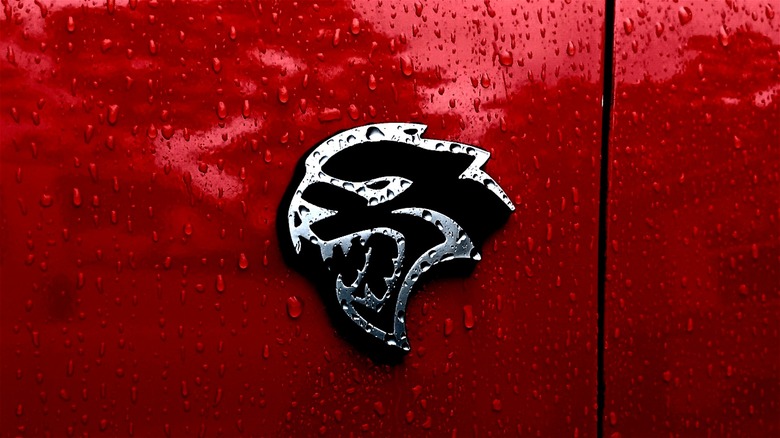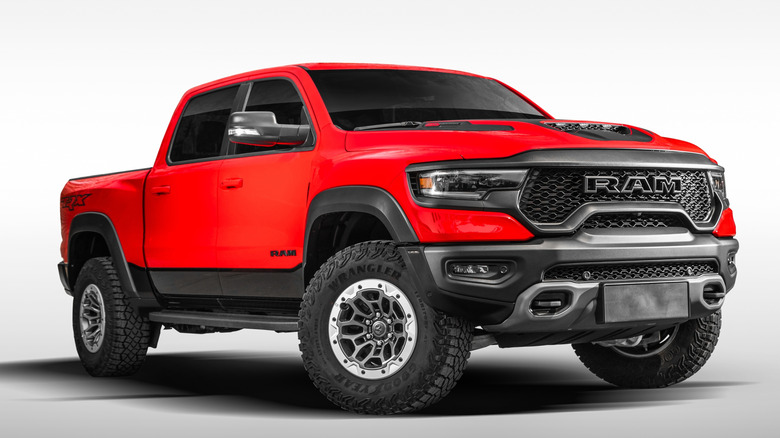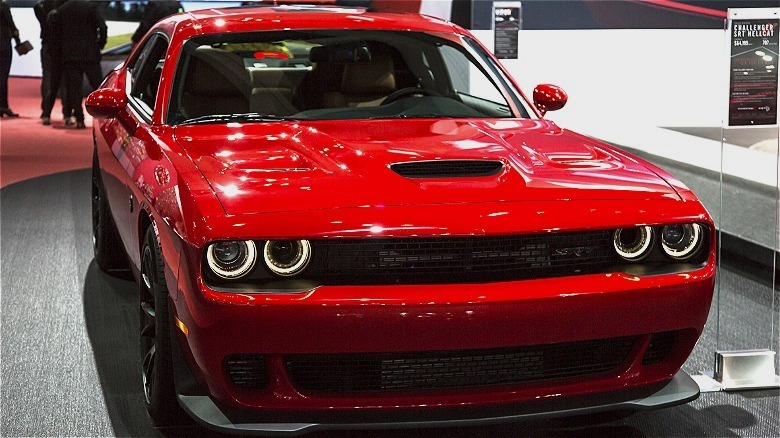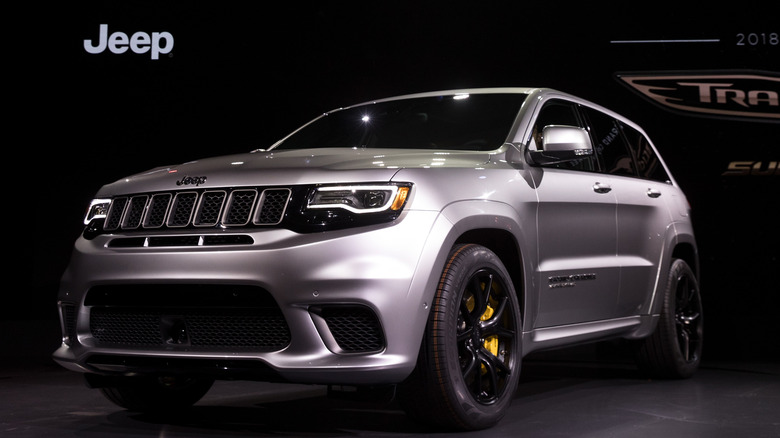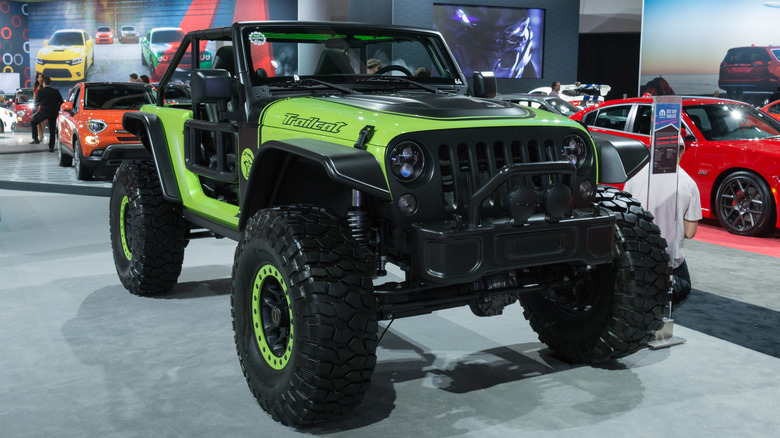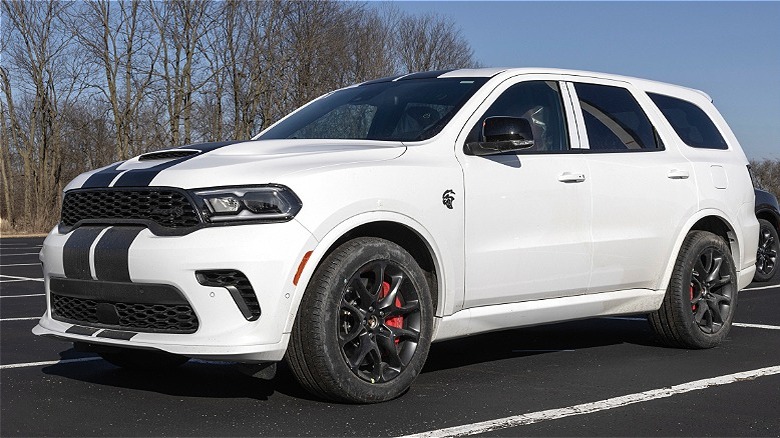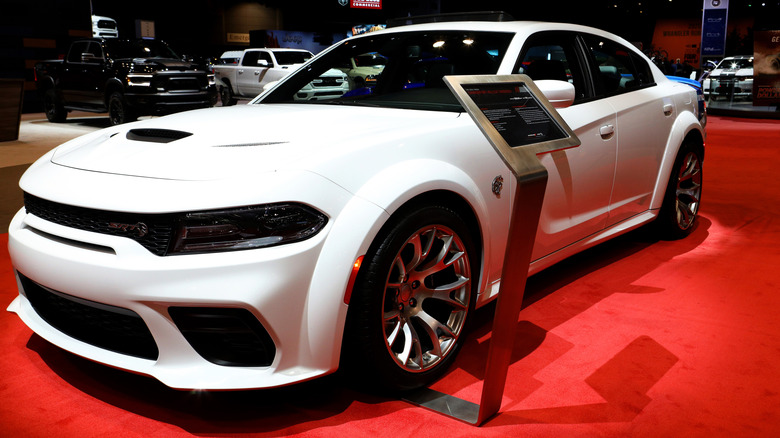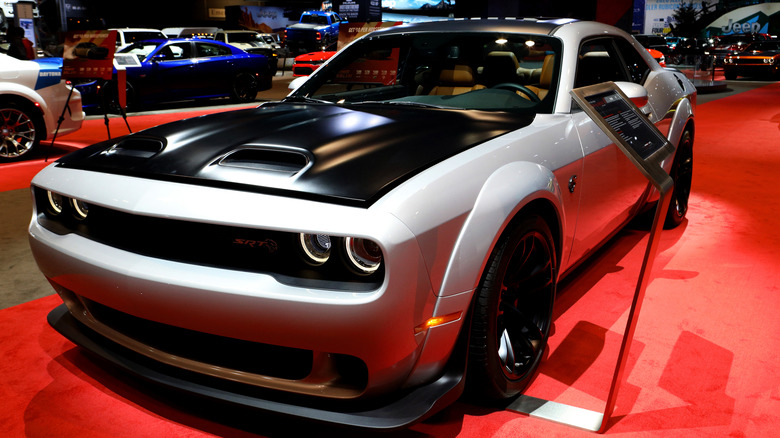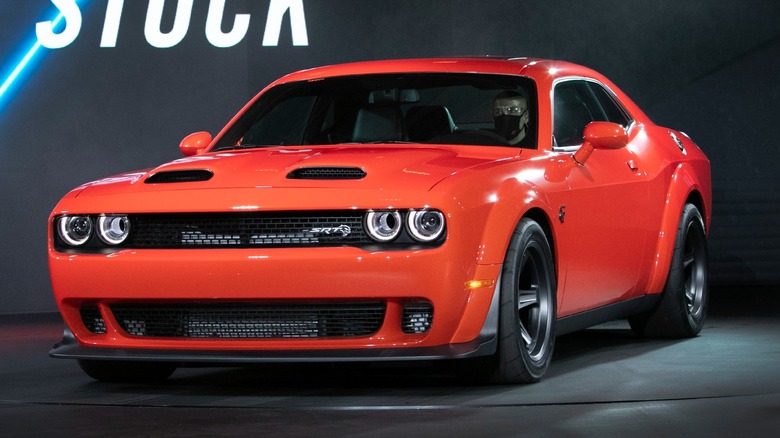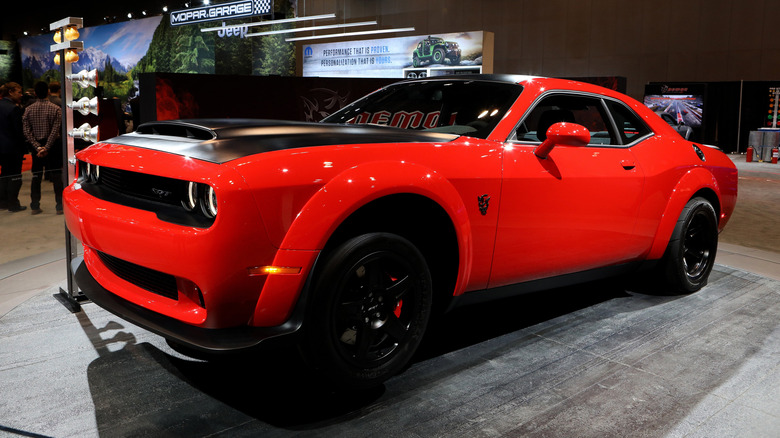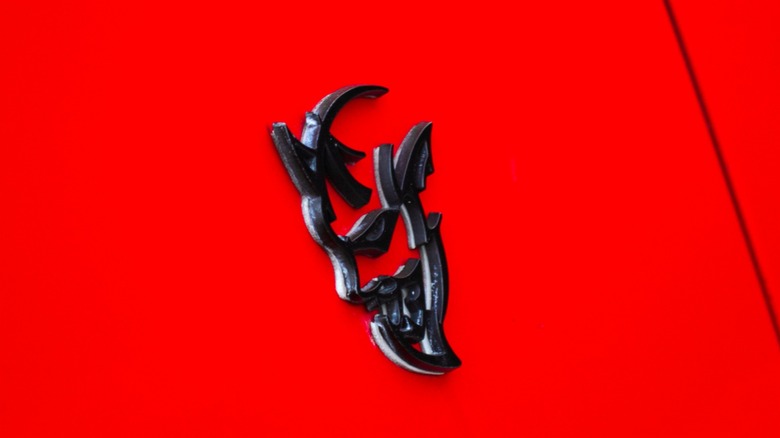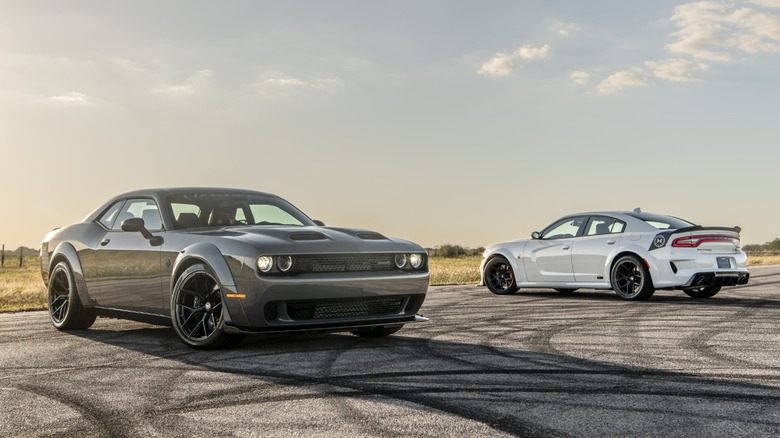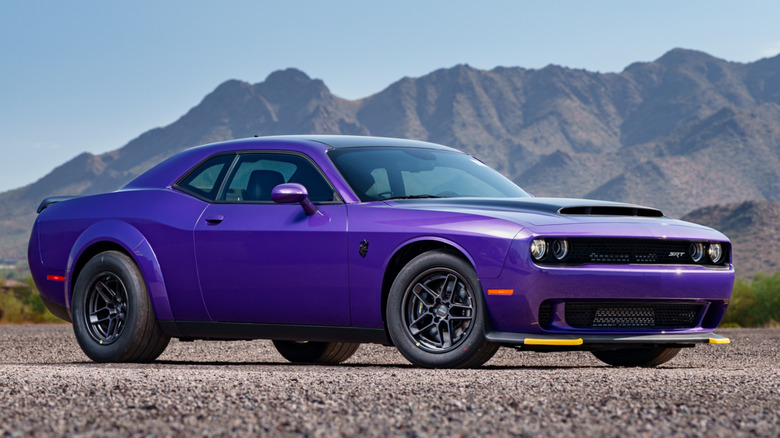13 Of The Coolest Hellcat-Powered Cars, Ranked By Horsepower
There are Ferraris, Porsches, Lamborghinis, and a dozen other high-horsepower nameplates out there, but among American muscle enthusiasts, few names ignite the same raw excitement as the Hellcat. Born from Dodge's desire to create the ultimate muscle car, the Hellcat dynasty has conquered and plundered the scene with fire-spitting fervor.
The beating heart of this empire is the Hellcat engine itself — a supercharged, 6.2-liter HEMI V8 that at its weakest still produces over 700 horsepower. This gas-powered crusader unites drivers and enthusiasts of all backgrounds under the shared banner of speed, pushing the limits of the muscle car renaissance since its debut in 2014. The Hellcat V8 oozes cool, so here are 13 of the coolest Hellcat-powered cars, ranked by horsepower.
Ram 1500 TRX
In 2020, six years into the Hellcat's reign over the muscle car kingdom, we saw the introduction of the Ram 1500 TRX. As if the Challenger and Charger Hellcat weren't American enough, the disciples of insanity behind the Hellcat project decided a truck needed the Hellcat treatment. The TRX's Hellcat motor produces 702 horsepower, the weakest of all Hellcat-powered cars. A ridiculous statement, but calling a 700 horsepower truck weak is a testimony to the Hellcat family's obscene capabilities. With its 702 horsepower, the 1500 TRX can hit 60 in 3.7 seconds, and it can also tow 8,100 pounds. Dubbed "the apex predator of the truck world" in the TRX's press release, this truck certainly lives up to its title with upgrades going beyond the engine bay.
Outside, the TRX wears new fender flares that widen its whole stance. The hood opens with a single scoop to feed air to the ever-ravenous 6.2-liter V8, and on its feet, it wears a set of Goodyear tires custom-made to meet the TRX's inclination for speed, and to deploy that speed in Mother Nature's most unforgiving arenas. These, plus some further upgrades to the truck's hardware, make it a formidable force on and off paved roads. This philosophy of exceeding capability is present in all Hellcat models, but it's nowhere more present than in the TRX. It's such a good car, it's difficult to understand why Ram discontinued it.
2015 Dodge SRT Hellcat
This is it, the one that started it all. Since its introduction in 2014, the Hellcat nameplate has redefined what the modern muscle car can be. Dodge's commitment to the original spirit of the muscle car is steadfast and concrete in the Hellcat. The ingredients are simple. An exterior with belligerant lines and an iron heart of an engine that exerts its will by brute force and a complete rejection of any form of nonchalance.
The 2015 Challenger SRT Hellcat and Charger SRT Hellcat were the conquerors of muscle that would lead a 10-year dynasty, and their abilities still hold up today. The original Hellcats received 707 horsepower from their supercharged V8s and could reach 60 in 3.6 seconds. Only at the doorstep of 200 mph, 1 mph away to be exact, do they reach their maximum velocity. These all come together to form an anti-hero that forces you to respect its power, character, and determination to assert its existence beyond the past from which it belongs. The original Hellcats set the standard for their offspring, a line of cars that, like a dying star, shine bright, hot, and fast.
Jeep Grand Cherokee Trackhawk
Similar to the Ram 1500 TRX's story, in 2018, Hellcat decided it wanted to expand its empire beyond the Dodge moniker. The Jeep Grand Cherokee is a relatively docile car — a mid-size SUV meant to carry families down the American highways at a comfortable cruise while still retaining some off-road capabilities. However, after Dodge got its hands on it, it became a different beast.
Similar to the TRX, the Trackhawk benefits from the new powerplant beyond its top speed increase, as its tow capacity is a solid 7,200 pounds thanks to the 645 lb-ft of torque. Like the original Hellcat, the Trackhawk receives the standard 707 horsepower from the HEMI V8, making it the most powerful Jeep ever made. The Trackhawk shoots to 60 in a breeze at just 3.5 seconds and tops out at 180 mph despite its colossal size.
Jeep Trailcat Concept
If you thought the 15000 TRX or the Trackhawk was the perfect off-road Hellcat, think again. Every year, Jeep hosts the Easter Jeep Safari in Moab, Utah, to show off and test their latest concepts. In 2016, one of those concepts was the Jeep Trailcat. The Trailcat presents itself as something kindred to a regular Wrangler although anything but a passing glance will show its differences are vast.
The Trailcat is built on the two-door skeleton of the Wrangler, and the concept wore an acidic shade of green. The most noticeable difference outside is the massive wheels and tires (39.5 inch BFGoodrich Krawler T/A tires to be exact) meant to carry the Trailcat across even the most inhospitable terrain. There are no doors, and the front bumper boasts a crossbar with extra lights. All together, these design elements make the Trailcat look like an experimental military Jeep in the best way possible.
The inner workings of the Trailcat are what make it truly special. It is, of course, powered by the classic, 707 horsepower Hellcat V8, but what really makes it stand out is its transmission. The Trailcat delivered its 707 horsepower via a six-speed manual transmission, with a black shift knob decorated with a Hellcat logo in the same bright green. A jacked-up Wrangler with a Hellcat motor and a six-speed manual is just about as good as it can get. Sadly, though, this off-road beast was never sold.
Dodge Durango SRT Hellcat
Continuing on the trend of Hellcat-powered SUVs and off-roaders, we move on to the Dodge Durango SRT Hellcat. In 2020, Dodge expanded its Hellcat kingdom through a new vessel, the Durango. The Durango was Dodge's ultimate family car. A three-row people carrier, the Durango could haul seven people with ease, but not with enough speed, apparently, so Dodge stuffed their now legendary engine into it and turned up the tempo.
In the Durango, the 6.2-liter V8 makes 710 horsepower, a three-point increase from the original iteration, and 425 lb-ft of torque. Thanks to the upgrade, the Durango can now shoot itself and its passengers to 60 in just 3.6 seconds as the eight-speed automatic gearbox doles out the power. This marriage of a colossal people-carrier and a full-blown muscle car engine was so absurd that Dodge originally planned on producing just 2,000 units of the car in six months. However, the Durango Hellcat was a massive hit with customers. So much so that Dodge decided to extend its production lifecycle well into 2025, with tons of special editions like the Durango Hellcat Hammerhead along the way.
Dodge Charger SRT Hellcat Widebody
Representative of the newer generation of Hellcats, the Dodge Charger SRT Hellcat Widebody takes everything the original versions did, and does them better. In 2020, two years after the Challenger, the Charger received the widebody configuration as an optional upgrade for customers. A rather to-the-point title, the widebody upgrade grants the Charger wider fender flares. These extended haunches give the car a more poised and gung-ho stance. However, they also grant a larger housing for wider tires, which results in a larger contact patch with the road and more grip. For a car whose preference for straight-line speed is so great, any extra help in those pesky corners is welcome.
Beyond the facelift outside, all widebody Hellcat Chargers post-2021 received an extra 10 horsepower from their supercharged V8s, bringing the total to 717 horsepower. These small upgrades may not seem like much, but they helped preserve the Hellcat DNA into the future model years. These upgrades kept the Hellcats relevant and, by extending their lifespans, helped give Dodge the blank canvases they'd need for the many special editions to come.
Dodge Challenger SRT Hellcat Redeye
On the topic of special editions, one such example is the Dodge Challenger SRT Hellcat Redye. On the outside, the Hellcat Redeye is nearly identical to a regular Hellcat. It wears the same body panels and keeps the same proportions. To the untrained eye, it's just a regular Hellcat. In fact, the only way to tell the difference is if you take a close look at the Hellcat badge nestled in by the front fender. Upon inspection, you will find the angry cat's eye to be colored a bright hot red, as the name suggests. This is the only real difference outside, but it indicates a hefty step up inside.
The Hellcat Redeye uses the same, 6.2-liter supercharged HEMI V8 as the regular versions except here, power is boosted to a blistering 797 horsepower. The engine's internals are lighter and more battle-ready, thanks to some upgrades to the crankshaft, connecting rods, and the pistons. This means the Hellcat Redye can reach 60 mph in a raging 3.6 seconds as it revs to its redline of 6300 rpm. Beyond the 60 mph benchmark, the Hellcat Redeye will tear all the way to 203 mph before its supercharged lungs run out of breath.
Dodge Challenger SRT Super Stock
Drag racing is entangled in the double helix of muscle car DNA, and as the Hellcat family is the modern emissary of such culture, it was only fitting that Dodge made a Hellcat built for the quarter mile. Born in 2020, the Hellcat Super Stock took a car already built for going fast in a straight line in the regular Hellcat, and further fastened it to the railroad tracks. The Super Stock featured a lot of upgrades, but by far the biggest one is the power increase. The Stuper Stock's version of the HEMI V8 pumps out a staggering 807 horsepower, making the Super Stock the stuff of nightmares for any quarter mile strip (which it crushes at just 10.5 seconds) or traffic intersection.
Beyond the increased power upgrade, the Super Stock is packed full of other features to make it the king of the drag strip. The Super Stock sports Nitto NTO5R drag radials to put the power on the ground and when the quarter mile marking has passed from the windshield to the mirror, the Super Stock's four-piston Brembo brake calipers join forces with the vented brake rotors to bring the car safely to a stop. The Super Stock also featured the regular Hellcat's iconic air intakes in the form of hollowed out headlights to help the car gulp in air as it shoots across the tarmac.
Dodge Charger Jailbreak
As the Hellcat entered its twilight years and the empire of muscle seemed to be preparing to march off into history, the Hellcat engineers knew they had to do something to celebrate what they had created. Part of this celebration came in the form of the Jailbreak edition Hellcats. The Jailbreaks were meant to give Dodge customers the full creative agency needed to build their Hellcats just as their hearts told them to. We've all been on the car configurator sites, where you select one paint color only to be told that you have to remove the carbon fiber trim to use that color. The Jailbreak edition removed all these silly rules, allowing any combination of features, colors, or materials to be specced together.
The Jailbreak was mostly about expression and customization, but it didn't forget the importance of power. The Jailbreak uses the same version of the Hellcat V8 found in the Super Stock, and it produces the same gigantic 807 horsepower as seen in its brother. The Jailbreak signifies the Hellcat's unchallenged reign and celebrates Dodge's well-loved creation.
Dodge Demon (pump gas)
Remember the Super Stock? The Demon is its father. In 2018, the Demon was unveiled as the ultimate version of the Challenger Hellcat. Although many of these Hellcat iterations are very similar and can be hard to identify from one another, the Demon is relatively easy thanks to its colossal hood scoop. This huge slit in the hood opens up to 45.2 square inches, making it the largest hood scoop fitted to a production car, and works in tandem with the Demon's hollowed out headlights to suck in cool air for the ever-ravenous engine.
As another measure to help keep the engine from overheating, Dodge fitted the Demon with what they call the "Power Chiller." The Power Chiller is a clever system that uses the coolant for the car's climate control system to assist with cooling the engine as well as the passengers. As the Demon drinks in air, part of it passes through a radiator in the front, which then feeds it to the rear, where it is cooled by the chiller unit and sent back to the supercharger for colder, more condensed air. The result of all this is a version of the Hellcat V8 that produces 808 horsepower.
Dodge Demon (racing gas)
However, that 808 figure is only on pump gas. When Demon customers specced their builds, there were a few options that caught the eye. The Demon came standard without the passenger seat or rear seats. Luckily for those who wanted to enjoy the Demon with some company, you could opt for the passenger seat back in for a dollar, and the rear seats back in for another dollar. There was one more dollar option, though, that was even more obscene. Again, for just one dollar, customers could opt for the Demon Crate, which included the systems and parts needed to turn the Demon into a full-blown drag racing machine.
Recipients of the Demon Crate got a set of thin wheels and tires for the front, a sport air filter, a set of tools, a floor jack, and some other goodies. Most importantly, though, the Demon Crate contained an ECU upgrade that allowed the Demon to run on racing fuel. With this fitted, the Demon could now produce 840 angry horses, and enough torque to lift the front wheels upon launch.
Hennessy H1000 Hellcat Last Stand
Similar to the engineers behind the Hellcat project, when John Hennessy heard of the Hellcat's imminent retirement, he and his eponymous auto company blessed the Hellcat with one last hurrah. The result is the Hennessy H1000 Hellcat Last Stand edition. As we're used to by now on this list, the exterior differences are minimal. The Last Stand Hellcats look identical to their untouched kin, save the Hennessy decal across the crown of the windscreen and a few other small decals and badges. However, under the hood and throughout the guts of the car in general, Hennessy made substantial changes to bring the last Hellcats to their full potential.
Part of the grocery list includes a larger supercharger, new fuel injectors, new ventilation systems in the engine, and an upgraded air induction system that provides more clean air to the beast inside. As a result, the H1000 Last Stand Hellcats crank out a massive 1,000 horsepower and fly to 60 in just 2.8 seconds.
Dodge Challenger Hellcat Demon 170
So here it stands at the end of it all. The Dodge Challenger Hellcat Demon 170 is the one to rule and end them all. This is the grand finale, the encore, and the applause and tears for the Hellcat family, all packed into one mean muscle car. The Hellcat Demon 170 pulls out all the stops from previous models and puts them all together. It also features some new and exclusive upgrades to stretch the platform to its absolute ends, such as a new, 3.0-liter supercharger.
That new supercharger produces a 40% increase in boost, which combines with the other enhancements to make a car that overflows with 1,025 wild American horses. The Demon 170 snaps to 60 mph before you can draw a breath at just 1.6 seconds and devours the quarter mile in just under nine seconds. The Demon 170 is the culmination of a decade of Hellcats, and the result is exactly as you'd expect.
